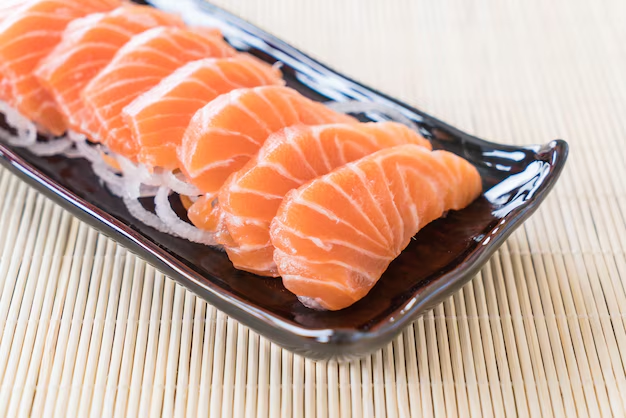Is Your Cooked Salmon Still Good? Discover How Long It Keeps in the Fridge 🧐
Salmon is a culinary delight enjoyed by many, known for its rich flavor and health benefits. However, even the tastiest piece must be stored properly to ensure safety and freshness. Have you ever found yourself peering into the fridge, wondering if that cooked salmon from a few nights ago is still safe to enjoy? You're not alone. Understanding how long cooked salmon lasts in the refrigerator is crucial for both taste and health. Let's dive into the ins and outs of salmon storage to keep your meals delicious and safe.
How Long Can You Keep Cooked Salmon in the Fridge?
Cooked salmon can typically last in the refrigerator for up to 3 to 4 days. This guideline is generally accepted among food safety experts. Keeping salmon any longer risks the development of spoiled flavors and harmful bacteria, making it a rule of thumb worth heeding.
Factors That Influence Shelf Life
Several factors can influence how long cooked salmon remains safe to eat:
- Temperature: Your fridge should be set at or below 40°F. Higher temperatures can speed up bacterial growth.
- Storage Method: How you store your salmon matters. Proper sealing and airtight containers can significantly extend freshness.
- Initial Freshness: The freshness of the salmon before cooking affects how long it will last. Fresher salmon before cooking will keep longer afterward.
Storing Cooked Salmon: Best Practices for Maximum Freshness
📦 Choosing the Right Container
Using the right storage container can make a big difference in preserving your salmon:
- Airtight Containers: These help prevent the salmon from absorbing odors from other foods, maintaining its flavor.
- Wrap It Up: If a container isn't available, tightly wrap the salmon in aluminum foil or plastic wrap.
Placement Matters
Where you store the salmon in your fridge can also affect its longevity:
- Top Shelves: Keep your salmon on an upper shelf to minimize temperature fluctuations that are common in the door sections.
Signs Your Salmon Might Have Spoiled 🤢
It's important to remain vigilant for signs of spoilage to avoid unpleasant or unsafe dining experiences. Here are indicators that cooked salmon has surpassed its prime:
- Off Odor: Trust your nose. Any funky or sour smells suggest spoilage.
- Color Changes: Fresh salmon will appear vibrant. A grayish or dull color can indicate going bad.
- Texture: Slimy or sticky surfaces usually hint at bacterial growth.
Thrifty Tips for Salmon Lovers
🐟 Making the Most of Your Salmon
You don't have to toss cooked salmon after three days if you use these clever tips:
- Freeze It: If you know you won't eat the salmon in the recommended window, freezing is a smart option. Ensure it's tightly wrapped.
- New Meals: Turn leftovers into salmon patties or incorporate them into pastas and salads for new dishes that stretch your salmon's culinary life.
The Power of Proper Planning
- Meal Prep: Consider planning meals in advance to avoid having salmon sit too long.
- Portion Control: Cook only the amount you need to minimize leftovers.
The Science Behind Food Safety 🔬
Salmon's shelf life isn't only about flavor; it's a matter of safety. Improperly stored seafood can harbor harmful bacteria such as Listeria and Salmonella. While cooking typically reduces these risks, re-exposing fish to contaminated environments can lead to foodborne illnesses.
Quick Tips for Safe Eating
- Reheating thoroughly: When reheating, ensure the salmon reaches an internal temperature of 165°F to kill any lingering bacteria.
- Avoid Room Temperature: Never leave cooked salmon at room temperature for more than two hours.
A Smarter Approach to Sustainability 🌍
Reducing food waste is important for the environment and your wallet. By learning the art of proper food storage, you're taking a step toward sustainable living.
Practical Takeaways for Conscious Consumers
Here’s a quick list to keep your salmon (and your conscience) in check:
- 📅 Time It Right: Consume within 3-4 days; freeze if necessary.
- 🧊 Keep Cool: Store under 40°F to stall bacterial growth.
- 🏷️ Label & Organize: Keep track of dates for quick identification.
- 🍲 Repurpose Creatively: Transform leftovers into new meals.
A Delicious Conclusion to Cooked Salmon Storage
Armed with knowledge about the shelf life of cooked salmon, you can now make smarter choices about how to store and enjoy your catch post-cooking. Remember, the keys to preserving freshness lie in proper temperature control, timely consumption, and clever meal planning. Embrace these practices, and continue to relish the savory goodness of salmon, knowing it’s both safe and satisfying. Happy dining!
